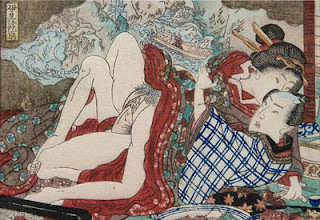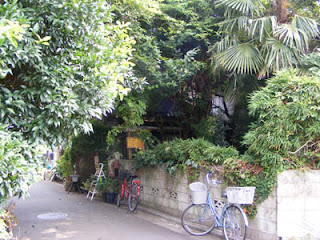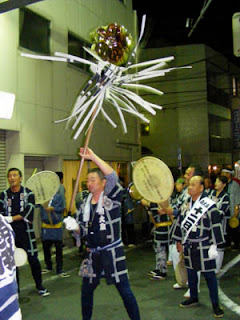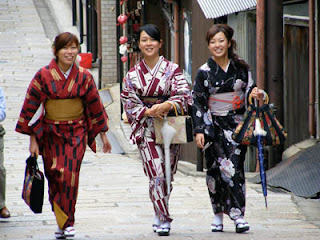 Konohanasakuya-Hime:Goddesss of fire and fertility Fuji-yoshida.
Konohanasakuya-Hime:Goddesss of fire and fertility Fuji-yoshida.
蝸牛
そろそろ登れ
富士の山
katatsumuri
soro soro nobore
fuji no yama
O snail,
Climb Mt. Fuji,
But slowly, slowly!
Kobayashi Issa (小林一茶)
This blog page has been completely replaced by our photoblogs:
Our journey now drives East through the mountainous areas of Honshu, slipping between Kyoto and Nara because we return to these places after returning the van in the urban wastelands half way between Tokyo and Yokohama, to consummate our time in Japan in the cultural capital.
 Shingon temple north of Uji with fire offerings
Shingon temple north of Uji with fire offeringsAs we left Awaiji we realized we were now taking the world's longest suspension bridge, a much huger more imposing structure than the one we entered the island from, totally dwarfing even the largest trucks and far larger than the Golden Gate in San Francisco. As we arrived in Honshu, we found ourselves in a bewildering spaghetti network of highways around Kobe. No matter which direction we took, we ended up traveling South West rather than the North East into the hills we sought to avoid the metropolitan paralysis of greater Osaka. After a lot of compass navigating and repeated mistakes, we managed to take a road into the hills as far as Ikeda, driving up into the Minoo Quasi National Park to stay the night on an isolated side road in the forest.
 Rock garden and Pagoda Ishi-Yamadera
Rock garden and Pagoda Ishi-YamaderaNext day we ploughed through the peripheral cities to the North of Osaka in fine weather in maniacal traffic speeding along two congested lanes interspersed with endless traffic lights, averaging about 20 kph, overtaken every two minutes by the Shinkansen bullet train careering past at some 300 kph. The highway then became entangled with a toll motor-way weaving in and out of its elevated pylons. We enarly ended up taking the toll road to try to cross the river to Uji at Shimamoto, but the men in the toll booth helpfully gave us a map to show us there was a parallel non-toll lane as well. We stooped in at Yawata to climb the forested hill to Iwashimisu jinja (a jinja is a Shinto shrine), with a beautifully decorated inner shrine under restoration, then on to Uji with a small world heritage Shinto shrine by the river and and the Byodin temple, whose Heian phoenix shrine is famously illustrated on the 10 yen coin, but found it closed for restoration, however we plan to return to it in a few days from Kyoto once restoration is over. We then took the river road passing by the temple, which ran around in a loop of hydro lakes from South East, eventually North, passing a colourful recluse Shingon temple on a hill with a lot of tributes to fire and flame, racing to Ishi-yamadera just before closing, when we found by accident it was lying in our path.
 Lady Murasaki's alleged room at Ishi-Yamadera
Lady Murasaki's alleged room at Ishi-YamaderaIshi-yamadera is a delightful Shingon temple set on a hill with beautiful shrines and altars, classic painted screens, a pagoda set above a rock and moss garden, and the room where it is alleged Lady Murasaki Shikibu wrote the Tale of the Genji, in the eleventh century Heian peak, for the women of the aristocracy. It is said to be the first novel, a title which shows how far ahead of European culture the Japan of the time actually was. The work recounts the life of a son of a Japanese emperor, known to readers as Hikaru Genji, or "Shining Genji". Genji is simply another way to read the Chinese characters for the real-life Minamoto clan, to which Genji was made to belong. For political reasons, Genji is relegated to commoner status and begins a career as an imperial officer.The tale concentrates on Genji's romantic life and describes the customs of the aristocratic society of the time. Much is made of Genji's good looks. His most important personality trait is the loyalty he shows to all the women in his life, as he never abandons any of his wives. When he finally becomes the most powerful man in the capital, he moves into a palace and provides for each of them, thus providing a unique insight into the sexual ethics of the imperial culture of the times. Yesterday while in Kyoto we went to another Matsura festival with chariots in Otsu adjacent to the shrine on the shores of Lake Biwa, very like the one in Kakunadote and one of the medieval floats had a marionette display with lady Murasaki and all the images of her novels parading before her.
 Float of Lady Murasaki and her creations Otsu Matsura
Float of Lady Murasaki and her creations Otsu MatsuraSuch tales are by no means fantasy. The original capital Nara had to be moved to Kyoto when a priest by the name of Dokyo managed to seduced an empress and nearly usurped the throne, and it was decided to move the court to a new location, out of the reach of Nara's increasingly powerful clergy.
 Japanese dress style: Miniskirts and undressing atire, Mag0me
Japanese dress style: Miniskirts and undressing atire, Mag0meTale of the Genji provides a counterpoint to the tale of erotic entrapment spun in "Woman of the Dunes" whose inspiration we was in the great sand dunes North of Tattori mentioned in an earlier blog. An entomologist on an expedition to collect insects in an area of sand dunes is entrapped in a sand pit by local villagers to assist a widow who has been tasked by the villagers with digging sand to be sold to the cities and preventing the sands from encroaching on the house and her village. Junpei eventually becomes the widow's lover and resigns himself to his fate. The focus of the film shifts to the way in which the couple cope with the oppressiveness of their condition, and the power of their physical attraction in spite of - or possibly because of - their situation. At the end of the film Junpei gets his chance to escape, but he chooses to prolong his stay in the dune, in part because the woman is already pregnant with his child.
 Female as 'Cherry Blossom'
Female as 'Cherry Blossom'Japan's fixation on doll-like images of woman shows clearly that the cliche of the fecund female as the nubile fertile child-like adolescent figure is not just a product of Western anorexia nervosa. Images of the doll-like geisha transfixed in her kimono extend through the soft-core girlie comics and magazines that litter every Lawson Station and Seven-eleven snack bar outlet, through kamakaze mini-skirted school girls, to young women carefully made up to look fragile to perfection as a cherry blossom petal, yet seductively adorned with clothes simulating a partially undressed state.
 Boy's girlie magazines in snack shop.
Boy's girlie magazines in snack shop.
This is possible partly because Japan's rule obeying and Buddhist non-violent mentality results in a low incidence of sex and other crimes and girls feel safe to walk in the street, even at night, without fear of attack. The seductive younger generation contrasts antipodally with the gentle forbearing conservative image of the older generation, leaving the statistics of Japanese people claiming to make love on average only 31 times a year, compared with the 144 times for New Zealanders, a mystery spanning the generations.
 Goddess of Mercy 'suckled' by two dragons Chomeiji
Goddess of Mercy 'suckled' by two dragons ChomeijiAt evening we drove up the Eastern shore of Lake Biwa where there were a long string of recreational beach-side parks, stopping in a car par with a toilet constructed by an ingenious recycling research project, which we found, having washed all our clothes, was providing the sweet-smelling water by filtering the sewerage outflow through six tanks of soil.
 Buddhist priestess, Setouchi Jakucho at Chomeiji
Buddhist priestess, Setouchi Jakucho at ChomeijiDriving North in the morning we stopped at a lakeside temple, Chomeiji, which had a very select altar with a forbidden image of the thousand armed Goddess of Mercy Kannon,, outside which a very famous woman Buddhist priestess, Setouchi Jakucho was being interviewed for a program on Japanese television. Only one of the Buddhist sects in Japan permits women to be consecrated priests, so I guess this was it. Later we would come to see her lecture posters in towns we drove through.
 Kimono art exhibition Hikone castle
Kimono art exhibition Hikone castleDriving north to Hikone, we stopped and climbed the hill and the Y 1000 fee to visit the castle and its lakeside formal garden with mirror reflections and an electrifying kimono exhibition with the models dressed as lady killer geishas. We then drove East past Gifu to Yaotsu, where we finally managed to get some silicone and paint to repair a few scratches on the van caused by backing into parking signs at Cainz Do-it-yourself chain that had everything from art supplies to building materials. Trying to find a place to crash we wound up at a strange very opulent sect-like peace settlement called The Hill of Humanity, and managed to descend into a derelict side road with a panoramic view of the valley below the hill overlooking a tunnel.
 Love hotel north of Nikko with penis nose and breast cheeks.
Love hotel north of Nikko with penis nose and breast cheeks.Next day we set off on the road from Yaotsu to Ena through the hills, but it rapidly degraded into a local farm alley that broke off into several directions with only signs in Japanese to the nearest villages, forcing us to navigate by compass, and to back track for 5 or 6 kilometres when on of the choices descended a deep valley and turned through 180 degrees to go South-West rather than the North-East we intended. Finally on one of them we recognized the Kanji for Ena and then drove on a tortuous little hill road through the forest with a large number of cars commuting to work, finally emerging into Ena after two or three hours lost in the hills.
 Venus love hotel with drive-in anonymous portal automatic registaration
Venus love hotel with drive-in anonymous portal automatic registaration
and cheaper rates for resting than sleepingWe stopped in at the Hotel Venus on the outskirts, a discrete love hotel with a drive-in core and an automated room service, offering different prices for overnight or 'rest', that prevented anyone seeing who arrived and who left. It was a cut above the seedy one we first saw driving up to Nikko, which had a man with a penis nose and a woman with breast cheeks on it.
 Magome
MagomeAfter failing to find Enakyo gorge and instead arriving at a hideous fun park on a flooded hydro-lake we then drove on to Magome and Tsumago, two old towns built on the Nakasendo (the old stone-paved medieval post road). Magome was delightful but rather touristic, but Tsumago over the saddle, on the other side of the range, was still in an unspoiled state, with a long meandering pedestrian only street following the old Nakasendo. Going through Iida, we pulled off for the evening near Oshika in a disused old loop of road by a bridge in the rain.
 Tsumago
TsumagoThe next day we drove into the Minami alps, ascending a winding back road named on the map as a major highway, stocking up with gas at the last gas station ascending the 1424 m summit road, coming down to Hase, where there was supposed to be a back road going by Mt. Kita the second highest mountain in Japan. This however proved, like those around and to Kamikochi previously could be traversed only by paying a hefty price for a bus ticket and was thus useless for a transit in the van. After nearly departing we returned to the alpine information center and was told by the woman on the desk that the tiny wiggle hexagon 20 was passable in the current conditions, even though the map showed it with a barrier road closed sign. We thus took of in the rain and mist up an exceedingly narrow windy precipitous little bush track that had no seal and in many places was fit only for a four wheel drive, but never quite petered out, despite coming at many places to locked gates with only one opening through, finally ascending Mt. Nyukasa 1955 m, all foggy and lichen hanging from the trees, eventually bursting out through a pair of farm gates from the wilderness onto a high plateau farm pasture, then descending in a wild bunch of hairpins to Fujimi and the valley down to Mt. Fuji. Views of this road are in the previous blog.
 'Private' love hotel Fuji Five Lakes
'Private' love hotel Fuji Five LakesFrom there it was a long drive south down a wide populated valley, before getting mired in the highways around Kofu where there was no turn off for the 358 to Fuji lakes, going East, but only going West, after we had overshot by 5 kms in rush hour traffic, because it took off from under a fly-over. We ended up sleeping on the slopes below Fuji five lakes right under the turn off to a viewing mountain called Ashigawa under the highway bridge by a precipitous valley with a stream in the entrance to a little deserted shrine. Another idyllic place brimming with nature that appeared out of nowhere.
The next day we drove around four of the five lakes in the pouring rain and mist-clad foothills with Fuji completely obliterated in the cloud cover. The first two smaller lakes were lined with devoted fishermen under umbrellas or in little tents erected over rowing boats, but the latter ones were tourist traps with hideous duck-shaped pedal boats littering the shore lines. The second lake had a cute little discrete love hotel called the Pr()ivate with a love heart in he place of the parentheses. Because of the rain we made it pretty much a rest day just trawling along the lake edges and hanging out in the towns. I got on the wireless internet and set up a fan-fold of Google maps to navigate through Tokyo and Yokohama suburbs to return the van and managed to park it up on a side street out of the rain to do a quick paint job on the few scratches we had made in the body work. In Kawaguchi despite being on the fore-front of a tourist town full of plush hotels, we managed to find an easy park we could spend the night right on the foreshore of the lake overlooking the opulence.
 Raisiing the shrine screen with scarlet-skirted female priestess
Raisiing the shrine screen with scarlet-skirted female priestess
of the fire goddess entering Fuji-yoshida.Next day took us on to Fujiyoshida, the main hub of the Fuji lakes area, and stumbled upon Sengen jinja, the Shinto shrine at the foot of the main trail up Fuji, just as they were carrying out the morning ceremonies of setting up the shrine and its fertility offerings. The shrine is dedicated to Konohanasakuya-Hime the Goddess of Fire and child bearing, who is propitiated annually in a big fire ceremony on August 26 at the end of the climbing season to ward off Mt. Fuji from erupting. The shrine comes equipped with golden arcs surmounted by phoenixes, carried through the town by the priests, along with a huge red replica of Mt. Fuji amid fire and dancing.
 Carrying the fertility offerings
Carrying the fertility offeringsHaving driven up Fuji until we became hopelessly submerged in the thick fog, we then drove down to the hub town of Gotemba and to the Hakone area to position ourselves closer to Yokohama for the journey back next day. Hakone is famous for views of Fuji and for the red Tori gate rising up in the lake edge at Hakone jinja. The old post road from Hakone then descended in a string of hairpins to the tourist gateway town to the Fuji area, Yamoto, past some hideous ticky tacky private Buddhist and Shinto temples with gold painted ersatz images, guard dogs and surveillance cameras, and spent the night tucked into the entrance to one of the old post road walking tracks. However Fuji is renowned in Japan as a very shy lady, so although I have seen it in the past, I have resorted to a journalistic foray to snap all the images of Fuji I can find, on tourist town billboards, the internet, on manholes, on pottery and even on kimonos. The result is a virtual tour to the summit and its various shrines and views from almost every vantage point we passed.
 Fertility altar at rear of the main shrine
Fertility altar at rear of the main shrineThe next day we returned through boisterous traffic on the 255, 246, 409 and local hexagon 2 to Hyoshi, the suburb of Tokyo-Yokohama where we had leased the van. By this time I really felt the I had learned to become a fearless Japanese driver riding the lights in convoy volleys as they all change phase in programmed sequence to let a cohort of traffic move at speed through about a kilometre of intersections at a time the same way they do in New York. Having cleaned out the van at a Lawson Station snack bar outlet because it is one of the few places you can dispose of rubbish, we finally arrived at 1 pm sharp to return the van five weeks after we had leased it for two, having faxed Kashiwa a note in Japanese and English translated by a helpful bank clerk in Tono so he would know we hadn't stolen it. Kashiwa was delighted to see us return with the van and shouted us both a lunch of Japanese noodles at the bar over the road. By evening we had finally made it back to Yoshida House in Tokyo again anonymous and apparently unscathed from the diabolical threats of instant fine or highway infringements which could bust the meagre budget of an impecunious traveler from New Zealand.
 Milestones looking like prehistoric monuments,
Milestones looking like prehistoric monuments,
old post road YamotoWe had a well-needed day's rest in Tokyo getting money from the post office ATM and venturing no further than the supermarket. However next day we took the local from Tokyo to Kyoto starting at 9.45 am, because the Shinkansen bullet train which only takes three odd hours coasts 13,500 yen rather than the meagre Y 7900 on the local. The Lonely Planet suggests it may involve up to four stops and take 8 hours, but things proved a little more complicated than that. The local involves multiple transfers where you come to a halt and wait for another local to take off in the same direction starting from the station you have been dumped off at, possibly shifted platforms with all your luggage. The trouble is that the station you end up at may not have a rapid transport train, which jumps minor stops, departing because it is only a local station, so you can get locked in a series of locals, slowing and complicating the journey. We had to wait for a new train to link onward, at Odawara, Atami, Shibawa, Numazu, Shimada, Hammamatsu, Toyahashi (15 min delay), and then took a local to Gifu (via Nagoya), but waited 12 mins at Okasaki to take a rapid instead to save time, passing Gifu to Ogaki. At Ogaki we then tried to take a limited express to Osaka via Kyoto, but got thrown off the train at Maibara because we hadn't paid a surcharge, where we waited another 20 mins to board a rapid bound for Himeji via Kyoto finally arriving at 7.35 pm, just over 10 hours later, finding we still had about 35 minutes on the local bus to get to Tani House by close to 8.30 pm, where we are now hanging out for 12 days of cultural respite!
 The iron penis carried in its portable shrine Hounen Matsuri,
The iron penis carried in its portable shrine Hounen Matsuri, Penis totem being carried from the Kanayama jinja
Penis totem being carried from the Kanayama jinja The Taga shrine at Uwajima has a penis log carried in festivals
The Taga shrine at Uwajima has a penis log carried in festivals



























































